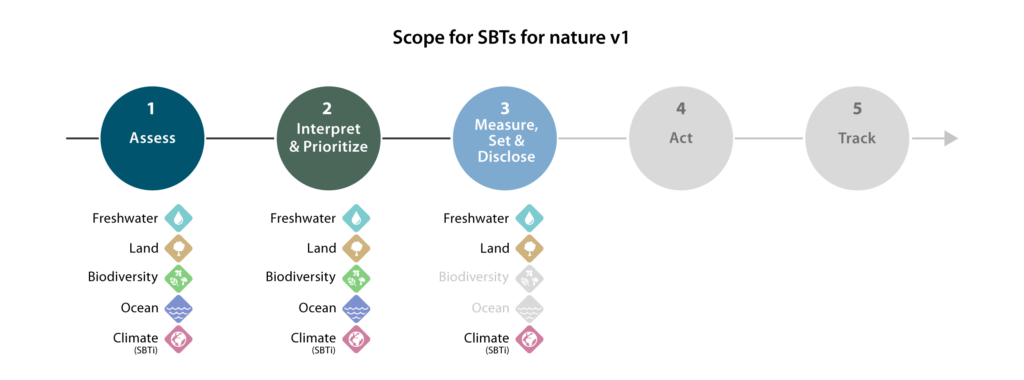
Inviting applications for initial corporate target validation
Initial Target Validation Overview
Science-based targets (SBTs) for nature V1 will be available for immediate use by companies from March 2023. Science Based Targets Network (SBTN) encourages all companies to use V1’s detailed methodologies to assess and prioritize their impacts on nature, and then progress to setting targets on freshwater, land and climate.

As SBTN will simultaneously launch the underlying process for companies to submit their targets for review and approval (“target validation process”), the target validation process itself will initially only be available to a small group of companies in order to gain learnings and optimize accordingly, prior to a full target validation process roll out later in the year. SBTN accepted applications from companies from January 6 – February 3, 2023.
The selection criteria for companies to participate in the initial target validation group were:
1
Readiness
Degree to which company has appropriate data as specified in the methods, technical capacity, and C-Suite and internal business support.

2
Representative
In terms of sector, geography of target-setting, value chain position.

Throughout 2023, companies that are members of the SBTN Corporate Engagement Program will receive regular updates regarding the initial target validation phase and will also be invited to continue to contribute to SBTN’s method development for V2. For any questions, please contact the Corporate Engagement Program team.
Frequently Asked Questions
What are the expected activities for the companies in this initial target validation group?
The initial target validation process will run from Q1-Q4 2023. SBTN will provide support to the initial target validation group through Q4, including office hours for questions of interpretation and charging no fee for validation during this initial period.
Companies in this group will be expected to:
- Share data required for target validation as indicated in the methods.
- Receive validation by SBTN of their assessment and prioritization of impacts on nature (Steps 1 and 2), and a subset of relevant land and freshwater targets (Step 3).
- Answer questions from the target validation team, provide the necessary evidence and documentation, and provide clarifications where needed.
- Begin creating action plans for achieving targets for all targets set. After this initial target validation process concludes, participating companies will be expected to complete target setting for all material target boundaries within the timeframes specified in SBTN methods.
What are the expectations around public communications and disclosures for companies?
- SBTN will publicly announce the companies participating in the initial target validation process when the work begins (likely March 2023). SBTN might consider allowing 1-2 companies to be “silent partners” if necessary for completeness in piloting the validation process.
- Companies in the initial target validation group commit to assessing and prioritizing their impacts on nature (Steps 1 & 2) and setting targets on freshwater and/or land (Step 3) including submitting targets for official validation to the SBTN; helping the SBTN pilot its target submission and validation process.
- SBTN will publicly disclose target progress with respect to boundary coverage and characterization (e.g. “water quality target in water basin X”) for each company.
- SBTN will distill lessons learned from the initial validation phase into an anonymized public report and revise the validation process if needed.
- Once the initial target validation phase concludes, participating companies will be expected to comply with pending claims and disclosure guidance like all other companies. Companies will communicate about their approved targets using SBTN’s pending claims guidance and approved language, and commit to reporting progress on an annual basis.
What are the proposed outputs for this initial validation phase?
SBTN is using this initial target validation group to pilot the target submission and validation process. The observations and learnings from the initial target validation companies’ work on assessing and prioritizing their impacts on nature (Steps 1 & 2) and setting targets on freshwater and/or land (Step 3) will be used to inform SBTN’s plans to scale. The V1 methods themselves will remain the same, but the validation process may be adjusted depending on results of the pilot by the initial target validation group. SBTN may share learnings from the initial target validation companies publicly, but this data will be anonymized.
If a company is not included and wants to set science-based targets for nature, what should they do?
We anticipate there will be motivated companies outside of the initial target validation group that will want to begin SBTs for nature. Companies not included in the initial target validation group are encouraged to prepare their targets as soon as V1 is publicly available in March 2023. V1 methods will not change as a result of the validation pilot period and when SBTN launches new method versions, the Network will provide a grace period for implementation.
SBTN will open up the validation process for any company to submit targets after distilling lessons from the validation pilot. Tentative timing is Q1 2024 and there will be a validation fee, price TBD. In addition, SBTN is updating other no-regrets actions and exploring the possibility of industry coalition commitments to support V1 rollout. SBTN is also exploring options for reviewing companies’ work on assessing and prioritizing their impacts on nature (Steps 1 and 2).
Setting SBTs for nature using the V1 guidance will help companies:
- Take the lead on ambitious corporate environmental action;
- Prepare, and be ahead of the game, for a broader set of complementary environmental targets to be released in subsequent versions by SBTN
- Demonstrate to stakeholders including customers, investors and employees their commitment to sustainability and transparency; and
- Proactively address risks such as future regulation and investor expectations.
What is SBTN’s plan for governance around the initial target validation process?
- An independent validation team within SBTN, drawn from SBTN’s Network partners, will be responsible for the target validation of the initial group of companies.
- SBTN shall develop an “Independence / Conflict of Interest policy” to delineate the scope of support to companies as well as the roles and functions of the validation team.
- SBTN will explore alternative options for the governance and management of the validation process to implement once the process is publicly available in late 2023.
What is SBTN’s approach to stakeholder engagement and social issues with respect to target-setting?
SBTN recognizes that engagement with different types of stakeholders is necessary throughout the target setting process: from impact assessment and prioritization to baselining and allocation, to determining ambition levels and actions, and then moving to implementation and tracking progress over time.
Because of the many stages of the target setting process where stakeholder engagement is relevant, SBTN is conducting a scoping exercise to ensure that additional guidance for companies on this topic is aligned with best practice, is in respect of human rights, supportive of locally-determined priorities and needs, and does not place undue burdens of engagement on the non-corporate actors engaged in the process.
The results of this scoping exercise and recommendations on stakeholder engagement practices to accompany the core SBT for nature methods will be available in early 2023.
What is SBTN’s approach to biodiversity and how will biodiversity be related to the V1 targets?
Biodiversity is defined as the variety of life at the ecosystem, species and genetic scales. SBTs for nature primarily focus on addressing biodiversity at the ecosystem and species level. The current land and freshwater SBTs for V1 directly address drivers of biodiversity loss, as captured in the Kunming-Montreal Global Biodiversity Framework. Please see here for more detail.
How is SBTN holding companies accountable and monitoring their progress post-V1 launch?
As an interim solution to measurement, reporting and verification (MRV) of science-based targets for nature, SBTN will be testing the use of ‘Action Plans’ (name to be determined) with the initial target validation group. In these plans, companies will be required to provide information to SBTN on how they will monitor and report on the progress against targets. It is anticipated that companies will publicly disclose their target progress.
Once SBTN has an established MRV system in place, we will begin to formalize requirements about corporate reporting (e.g. to SBTN or other parties), as well as share results of progress gleaned through monitoring (e.g. through satellite or other technologies) and through verification (e.g. through third-party actors engaged by companies to assess their progress).



